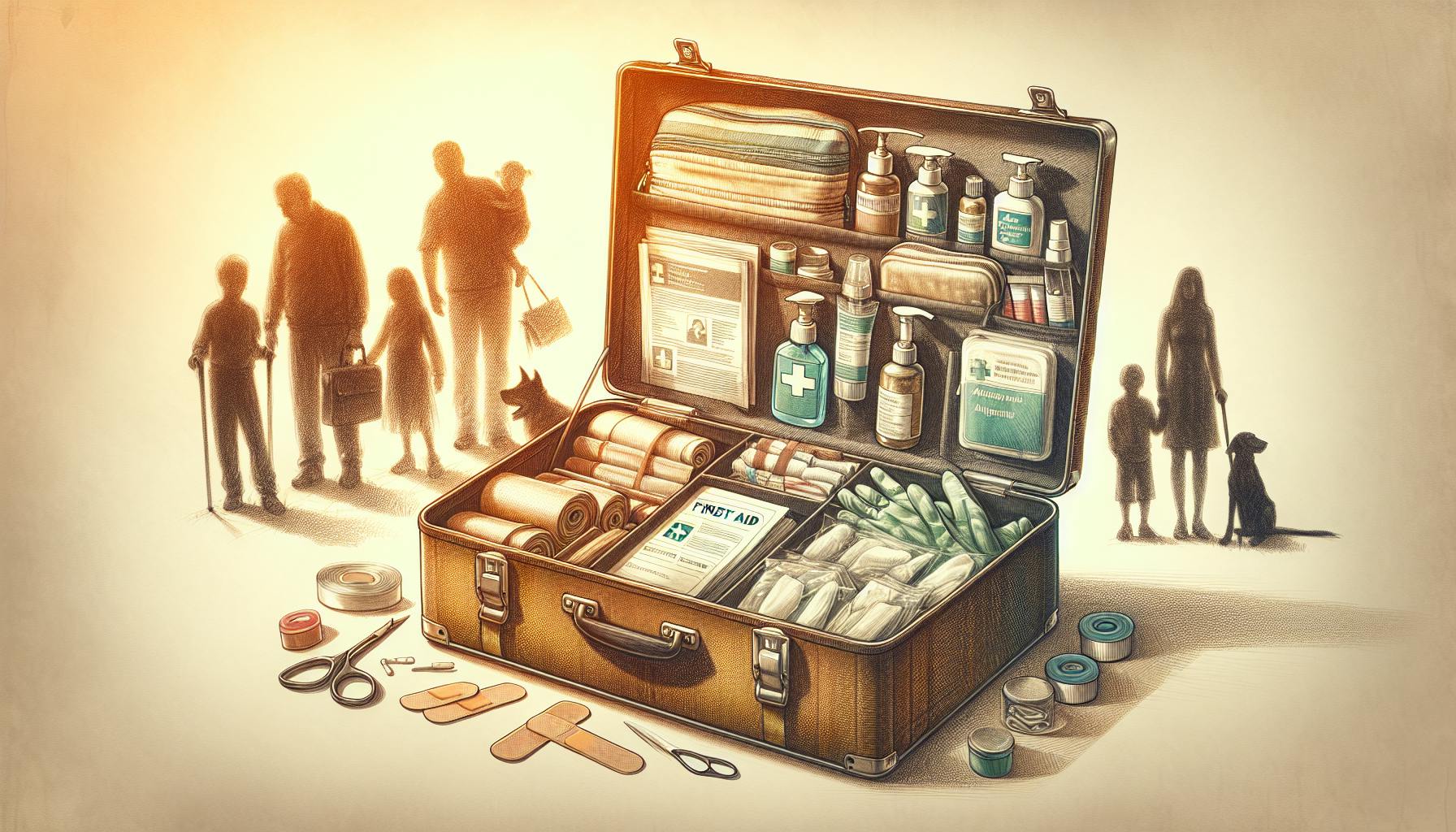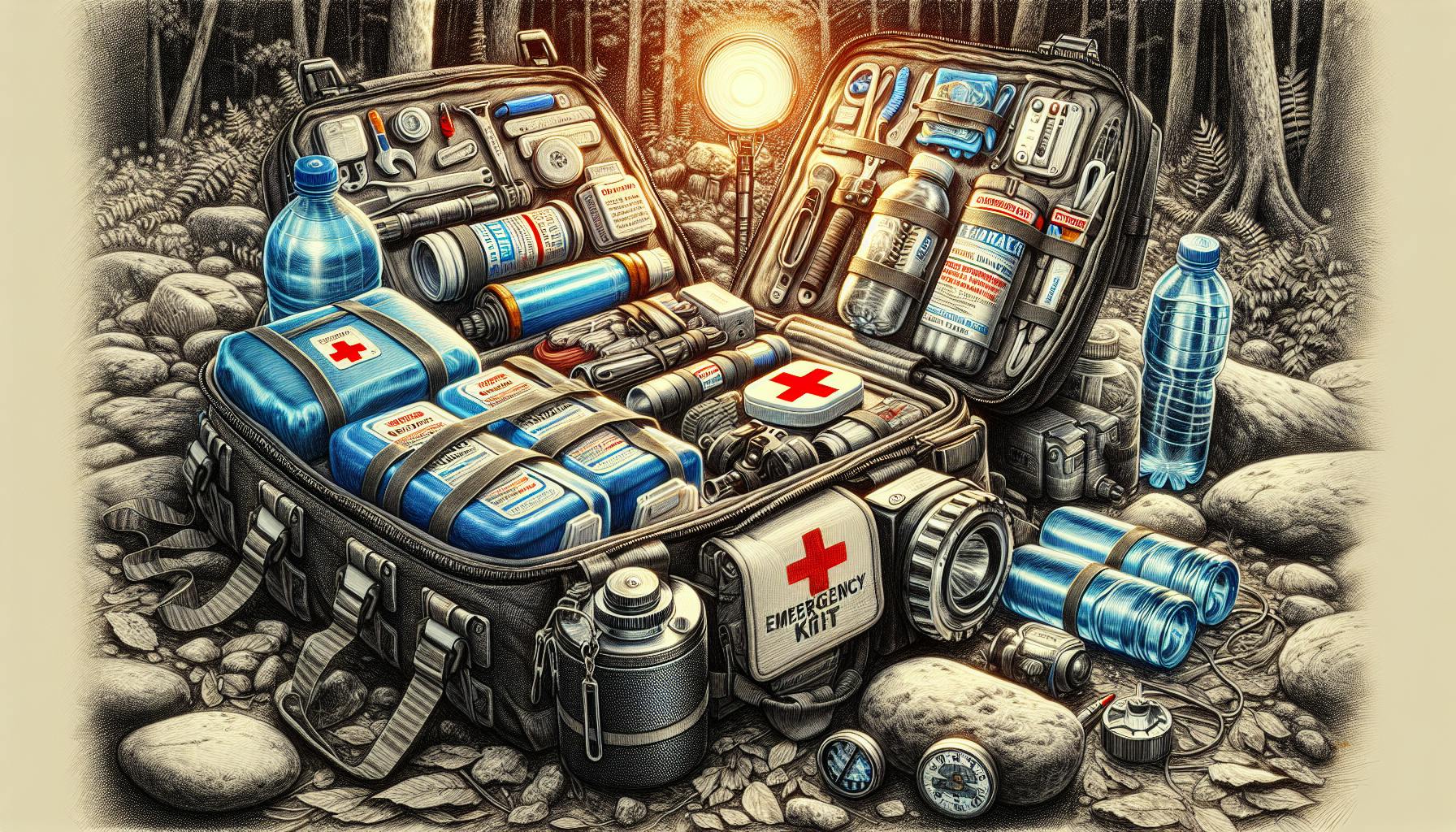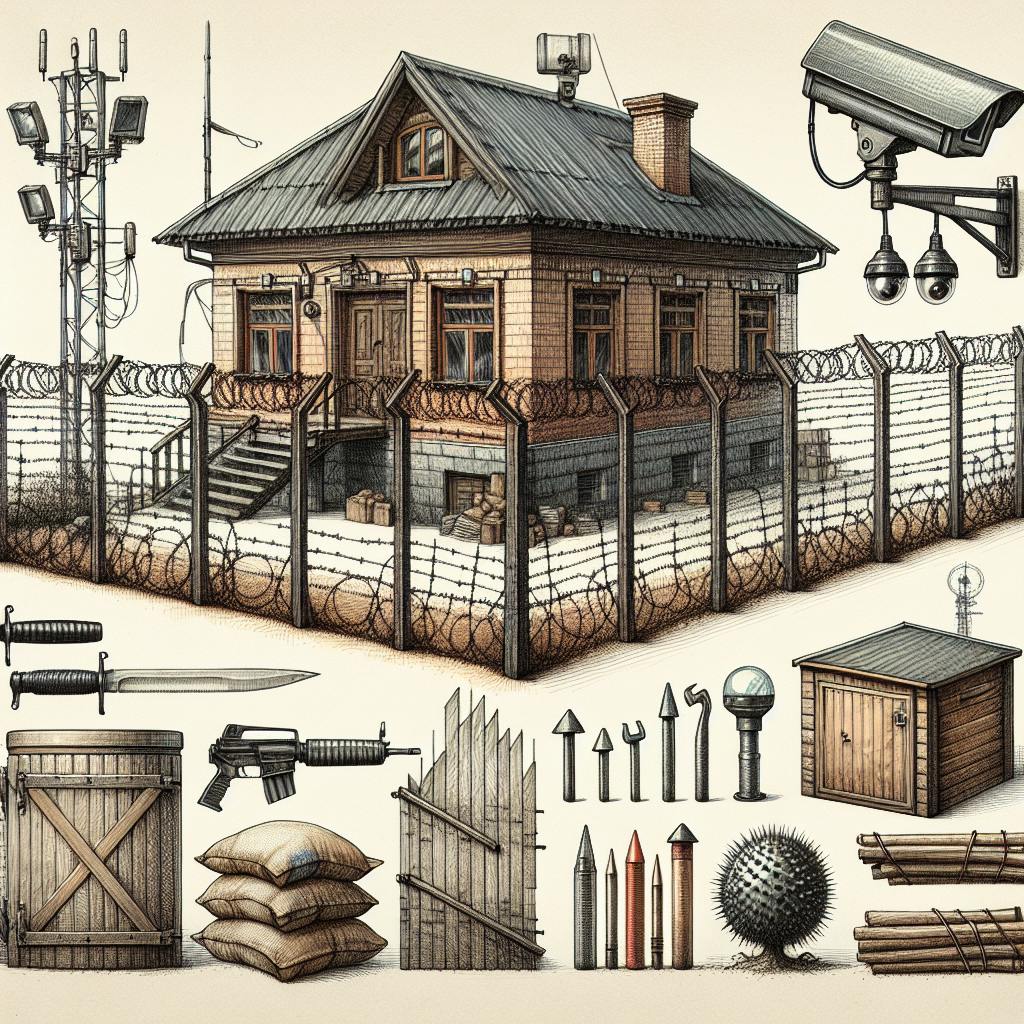Preparing a full year's worth of survival food is a daunting task for most families.
This comprehensive guide will walk you through everything you need to know to create a realistic, affordable, nutritious one-year food supply tailored to your family's needs.
You'll learn how to calculate the right amount of food for your household, build a balanced diet, store food properly, supplement with gardening and livestock, and develop vital community connections and survival skills.
Introduction to 1 Year Survival Food Planning
When planning for a 1 year stockpile of survival food, the key considerations include assessing your family's nutritional needs, creating a budget, and determining the necessary storage space.
Assessing Your Family's Nutritional Needs
To stay healthy over a 1 year timeframe, the recommended daily nutritional intake per person is:
- Calories: 2,000 - 2,500
- Protein: 50g
- Fruits/Vegetables: 5 servings
A sample daily meal plan meeting these needs could include:
- Breakfast: Oatmeal, dried fruit, powdered milk
- Lunch: Rice, canned beans, canned vegetables
- Dinner: Pasta, canned tuna, canned tomatoes
- Snacks: Granola bars, beef jerky
Focus on stocking non-perishable, calorie-dense foods to meet energy needs. Include a variety of food groups for nutritional balance.
Creating a Budget for 1 Year of Food
Budgeting for a 1 year food supply involves estimating costs for items like:
- Staples: rice, beans, pasta ($150)
- Canned goods: tuna, vegetables, soup ($300)
- Snacks: granola, jerky ($180)
The estimated total for 1 person is $750. For a family of 4, that equates to $3,000.
Tips to reduce costs include:
- Buying in bulk quantities
- Purchasing during sales or with coupons
- Substituting some purchased foods with home-canned or preserved items
To stay within budget, focus spending on nutritious, non-perishable basics over more expensive specialty items.
How much food do you need to survive one year?
You will need a significant amount of food to survive for one full year. As a general guideline:
- For 3 days, plan for 3,600 - 4,500 calories per person
- For 2 weeks, plan for 16,800 - 21,000 calories per person
- For 1 month, plan for 33,600 - 42,000 calories per person
- For the full year, you will need 403,200 - 504,000 total calories per person
When calculating your one year food supply, be sure to account for:
- Your daily caloric needs based on age, gender, activity level, etc. An average adult needs 2000-2500 calories per day.
- Nutritional variety and balance across food groups
- Accounting for food spoilage and waste
- Fluctuations in calorie needs due to changes in activity, health status, etc.
Focus your supply on shelf-stable foods with a long expiration date such as grains, beans, canned goods, and freeze-dried meals. Properly storing your food supply will also help it last the full year.
With smart planning and preparation, you can build a 1 year food supply to feed yourself and your family in an emergency situation.
What food is best for long term survival?
Rice, beans, pasta, cereals, and dried fruits are all nutritious, long-lasting options for a 1 year food supply. Focus on non-perishable foods that provide calories, protein, vitamins and minerals. Some good choices include:
- Rice - White, brown, jasmine, basmati, wild rice provide carbs. Opt for whole grains when possible.
- Beans - Black, pinto, kidney, chickpeas, lentils are packed with plant-based protein.
- Pasta - Elbow macaroni, spaghetti noodles, penne store for years. Choose whole grain varieties.
- Cereals - Oatmeal, granola, muesli give you fiber. Look for low sugar kinds.
- Dried Fruits - Raisins, cranberries, apricots add sweetness and nutrients. Prioritize unsweetened ones.
Canned foods like tuna, salmon, chicken, vegetables and soups also make handy additions.
Focus on nutrient density, not just calories. Variety is important to get all vitamins and minerals you need to stay healthy. Lean proteins, fruits, vegetables, and whole grains should make up the bulk of your long term food prep.
Convenience is also key for your 1 year food supply. Opt for ready-to-eat cereals, pasta salad mixes, rice mixes that just require water and short cook times. Food fatigue is real, so having diverse flavors and textures will make your meals more enjoyable.
When building your 1 year food supply, think about dietary needs, budget, and storage space. Calculate daily calorie needs for each family member and plan accordingly. Prioritize nutritious, budget-friendly foods that pack the most calories per pound. And consider compact foods like dried and canned items if storage space is limited.
What are the top 10 survival foods?
When building your one-year food supply, it's important to stock up on non-perishable foods that provide balanced nutrition. Here are 10 of the best survival foods to include:
- Whole grains like rice, quinoa, oats, and pasta. These are filling, packed with energy, and have a long shelf-life. Go for brown rice and whole grain pasta when possible.
- Canned goods like beans, vegetables, fruits, soups, and meats. Canned goods are convenient, affordable sources of protein, fiber, vitamins and minerals. Stock a variety!
- Nuts and seeds like almonds, walnuts, sunflower seeds, and chia seeds. These are calorie-dense and loaded with healthy fats and protein to keep you fueled.
- Lentils and beans like chickpeas, black beans and kidney beans. Excellent sources of plant-based protein and fiber. Stock up on versatile lentils.
- Canned, frozen or dehydrated vegetables like carrots, spinach, sweet potatoes, and green beans. Essential for nutrients and variety.
- Canned, frozen or dehydrated fruits like pineapple, peaches, mixed berries. Store multiple fruits to prevent boredom.
- Powdered milk, shelf-stable milk boxes, and powdered eggs. Useful dairy items with nutrients like protein, calcium, and vitamin D.
- Canned meats like tuna, salmon, chicken, and beef. Lean meats provide much-needed protein.
- Honey, maple syrup, salt, spices, baking soda and baking powder for cooking/baking needs.
- Multi-vitamin supplements to fill any nutritional gaps.
Focus on nutrient density, affordability, shelf-life and versatility when stocking up on these staple survival foods.
What survival food has the longest shelf life?
Freeze-dried meat is an excellent long-term protein source for emergency food storage. With a shelf life of over 25 years when properly stored, it outpaces other survival food options. Freeze-dried meat is lightweight, easy to prepare by just adding hot water, and as nutritious as fresh meat.
Here are some of the reasons freeze-dried meat is the best choice for long-term food storage:
- Extremely long shelf life: With a 25+ year shelf life, freeze-dried meat lasts longer than any other type of meat or protein. You can store it for decades.
- Lightweight and compact: Because the moisture has been removed, freeze-dried meat is very lightweight. It won't take up much precious storage space.
- Easy, fast preparation: To prepare freeze-dried meat, simply add hot or cold water and wait a few minutes. This makes meal prep fast and easy in an emergency.
- Nutritious: The freeze-drying process preserves nutrients like protein, vitamins and minerals. Reconstituted freeze-dried meat contains the same nutritional value as fresh meat.
With its unmatched shelf life, freeze-dried meat is quite simply the best option for stockpiling protein. It should be a core component of any 1-year, long-term survival food supply.
Key Food Items for Your 1 Year Stockpile
When preparing your one-year food supply, focusing on shelf-stable items that provide a balanced mix of proteins, fats, carbohydrates, vitamins and minerals is key. Here are some of the most critical categories to stock up on:
Proteins
Canned meats like tuna, chicken, salmon and spam can provide protein and last 1-2 years when properly stored. Freeze-dried meats, TVP (textured vegetable protein) and protein powders also have long shelf lives. Aim for 0.5-1 pound per person daily.
Fats and Oils
Fats are essential for energy and nutrient absorption over an extended disaster scenario. Prioritize shelf-stable options like coconut oil, olive oil, nuts, nut butters, and seeds. Calculate about 30% of total calories from fats.
Grains and Legumes
Rice, beans, lentils, oats, pasta and quinoa provide balanced carbs. Focus on whole grains when possible. Combine with legumes to make complete proteins. Figure around 60% of calories from carbs/grains.
When assembling your 1 year stockpile, calculate total calorie needs for your family and use that to allocate appropriate amounts of proteins, fats, fruits, vegetables and carbs. Store items properly and rotate as needed. Supplement with a multivitamin.
sbb-itb-b932644
Vitamins and Minerals
Discussing long-term nutrition planning can ensure you meet vitamin and mineral needs over an extended survival timeline. Having a supply of shelf-stable fruits, vegetables, and supplements can help promote health.
Fruits and Vegetables
Canned, freeze-dried, and dehydrated fruits and vegetables are important for meeting vitamin and mineral needs. Having a variety helps ensure adequate nutrition. Some options to consider storing include:
- Canned fruits and vegetables, like carrots, green beans, peaches, and tomatoes
- Dehydrated veggies like carrots, spinach, kale, peppers, and sweet potatoes
- Freeze-dried berries and tropical fruits
When building up a long-term supply, focus on fruits and veggies you enjoy eating. Having options like apple slices, banana chips, and dried mango can make survival meals more appetizing over time.
Multivitamins
Taking a daily multivitamin can serve as an insurance policy against potential nutritional gaps. Over an extended survival period, having supplements on hand provides an added safeguard to help meet vitamin and mineral needs if food variety becomes limited.
When purchasing multivitamins for emergency supply, look for shelf-stable tablets rather than gummies or liquids. Aim for a modest potency formula without mega-doses of specific nutrients. Store supplements in a cool, dark place and routinely check expiration dates. Rotating stock helps ensure freshness over the long-term.
Having both food sources and supplements available provides redundancy in meeting vitamin and mineral needs over a 1 year survival timeframe.
Food Storage Considerations
When stockpiling a 1 year supply of survival food, proper storage is critical to maximize freshness and shelf life. Here are some best practices:
Storing in Cool, Dry Place
- Store food in a cool, dry, dark place with temperatures between 50-70°F. Temperature fluctuations can impact shelf life.
- Ensure low humidity levels below 70%. High humidity can lead to mold growth.
- Use sealed containers, oxygen absorbers, nitrogen flushing or vacuum packing to limit oxygen exposure. Oxygen causes food spoilage over time.
- Monitor for pests like insects or rodents. Use traps if needed and inspect packages for damage. Infestations will contaminate food.
Proper conditions are key for long term storage. Monitor and control temperature, humidity, oxygen levels and pests. This helps survival foods stay fresh for the full year.
Inventory Management and Rotation
- Catalog all survival food by purchase date and shelf life. First-in, first-out rotation ensures older food gets used first.
- Clearly label containers with contents and dates. This streamlines finding specific foods.
- Set reminders to routinely cycle older food to the front of storage. Consumption before expiration prevents waste.
- Inspect inventory at regular intervals for damage or spoilage issues. Promptly remove and replace compromised food.
Staying organized and rotating stock ensures you can locate foods easily and use up older inventory prior to deterioration or expiration.
Cooking Considerations for Survival Foods
Cooking and meal preparation with long-term survival food stocks requires some special considerations. Having the right tools, fuel sources, and recipes tailored to shelf-stable ingredients can make all the difference.
Cooking Tools and Fuels
When cooking for long-term survival situations, key tools and fuel sources include:
- Camping stoves
- Cast iron cookware
- Manual can openers
- Propane
- Charcoal
- Firewood
Portable camp stoves run on propane or other fuels are essential for cooking off-the-grid. Cast iron pots and pans can cook evenly over open flames. Manual can openers are a must for getting into canned goods.
Having backup sources of cooking fuel is also important. Propane tanks, charcoal bags, and gathered firewood can all be used to fuel survival cooking setups. The ability to utilize multiple fuel types provides flexibility if certain sources become scarce over an extended timeframe.
Recipes and Meal Planning
Getting creative with recipes and meal plans is key to keeping up morale and nutrition levels when relying on survival food stocks for longer stretches of time. Some tips include:
- Incorporate variety by using different base ingredients like canned meats, beans, vegetables, and starches.
- Make one-pot meals like stews, chili, and rice dishes to conserve fuel.
- Bake survival breads and desserts when possible to boost morale.
- Plan balanced meals and vary cooking methods to maximize nutrition.
- Track inventory and rotate ingredients to prevent food fatigue.
- Share recipes and cook communally to foster community.
With some adaptation, shelf-stable survival foods can be made into tasty, nutritious meals over the long haul. Having the right mindset, tools and creative approach to on and off-grid cooking makes all the difference.
Securing a Reliable Survival Food Supply Chain
If planning for greater than a 1 year survival timeframe, establishing additional food sources through gardening, livestock, hunting, and foraging can provide critical supplementation and self-reliance. However, pursuing these activities requires careful planning and preparation.
Gardening and Livestock Basics
When getting started with gardening and raising small livestock in a survival scenario, focus on high-yield, hardy crops and animals that provide maximum calories and nutrients while demanding minimal space, labor and inputs. Some examples include:
- Crops: potatoes, sweet potatoes, beans, corn, squash, leafy greens. Choose disease-resistant heirloom varieties acclimated to your region.
- Livestock: chickens for eggs and meat, rabbits, goats for dairy products. Select breeds suited for backyard farming.
Plan crop rotations, space plants densely, and maximize vertical growing areas. Collect water runoff, compost food waste, and feed vegetable scraps to animals. Start seeds indoors and choose early-yielding varieties to extend the harvest. Learn preservation techniques like canning, pickling, and curing.
Hunting, Fishing, and Foraging
To supplement food reserves long-term from the wild, focus on abundant game like deer, squirrel and fowl. Bowhunting equipment allows for reusable ammunition. Target common panfish, bass, trout and catfish in local waters. Always confirm sustainability and identify plants accurately before foraging. Useful wild foods include:
- Wild greens and mushrooms
- Berries and fruits from shrubs and vines
- Nuts from trees like walnut, hazelnut and pecan
- Wild herbs like mint, thyme, cattail, dandelion
Learn skills like trapping, snaring, fishing spear making, and plant identification. Process and preserve all hunted and foraged food safely. Gradually become self-sufficient through nature's bounty when surviving long-term.
Community and Skills Development
Emphasize that a resilient community with a diversity of skills and resources is vital for long-term survival.
Building Community Connections
Getting to know your neighbors and hosting community events can help build connections that provide support in an emergency. Consider hosting a neighborhood potluck or block party to open conversations. Exchange contact information and discuss special skills, equipment, or other resources neighbors can share if disasters occur.
Identify and connect with local community groups, religious organizations, nonprofits, clubs, and more that align with your interests. Attend their events when possible to expand your community network. Having a web of support from various groups and individuals nearby can prove invaluable if access to outside aid is limited during a crisis.
Learning Survival Skills Together
Community-based education expands knowledge across your local network. Consider hosting workshops on relevant skills like emergency first aid, ham radio operation, hunting, food preservation techniques, and more. Or attend such events hosted by others to both learn and share your own expertise.
Building community resilience requires a diversity of competencies across groups and individuals. Play to your strengths while learning from those with different talents. An openness to teach and learn from one another is key to surviving disasters that require broad capabilities spanning medical care, communication systems, food acquisition and storage, and beyond.
Final Thoughts
In conclusion, having an adequate supply of survival food is crucial for emergency preparedness. When planning for a 1 year stockpile, here are some key considerations:
Assess Your Family's Needs
- Take into account each family member's age, gender, activity level, and any special dietary needs
- Factor in food allergies or religious/ethical food restrictions
- Determine daily caloric requirements and nutritional needs
Budget Accordingly
- Research bulk and freeze-dried survival food options
- Calculate costs based on your family's size and needs
- Set aside funds each month to build up your supply over time
Store Properly
- Use oxygen-absorber packets and air-tight containers
- Keep food in a cool, dark, and dry location
- Rotate stock as you replenish, using older food first
The goal is to have a balanced, nutritious food supply to sustain your family in an extended emergency. Focus also on building community resilience through neighborhood preparedness groups. As with any skill, continual learning about emergency preparedness is key.


